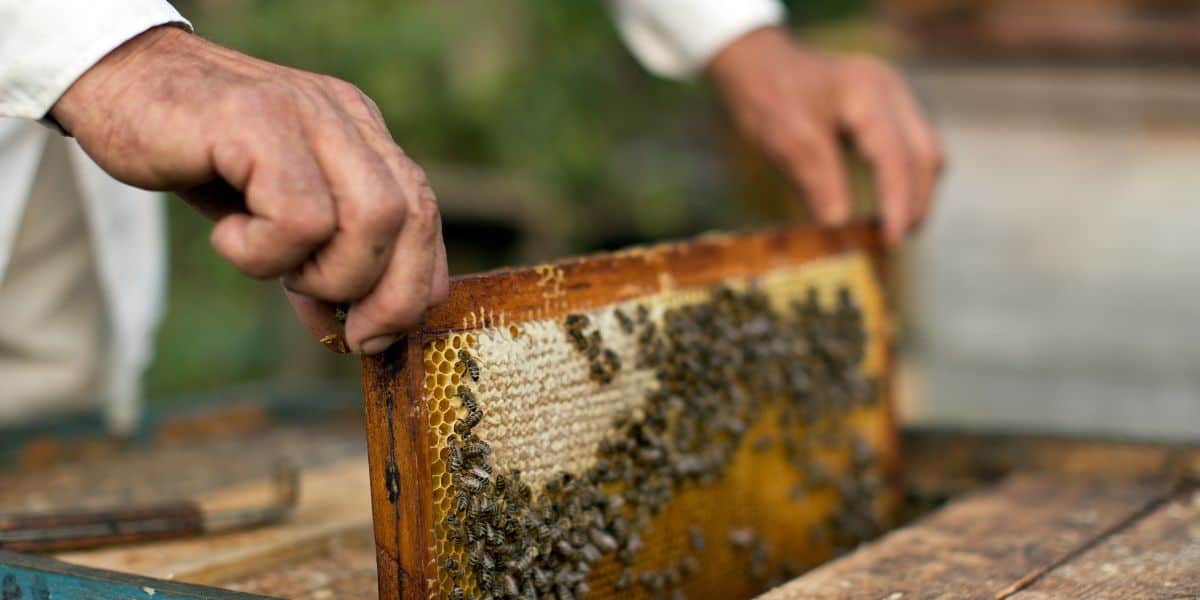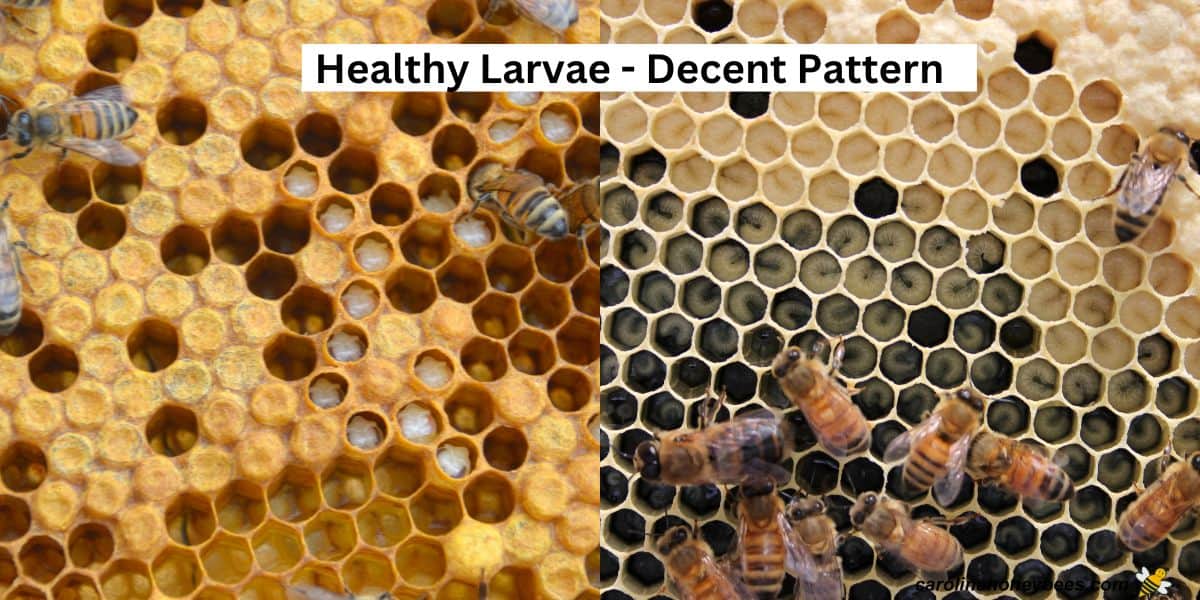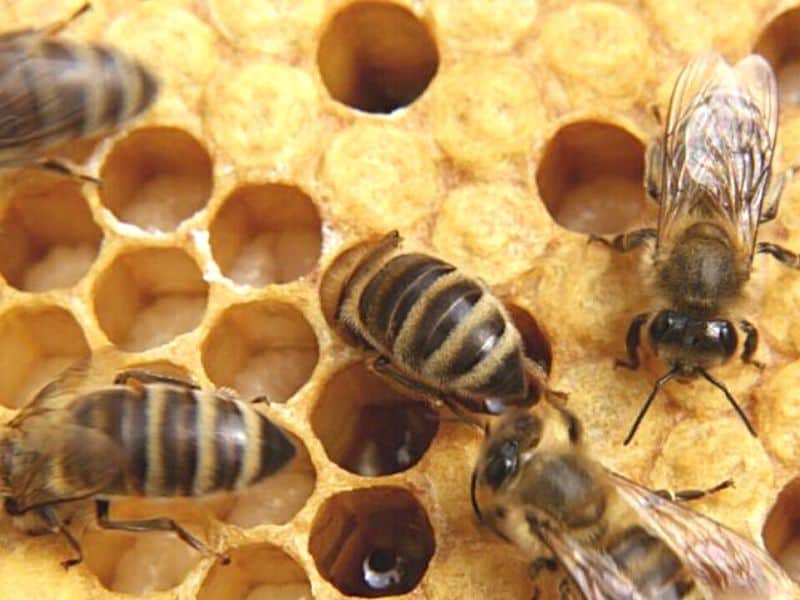European Foulbrood
European Foulbrood (EFB) is a bacterial disease that affects bee brood (developing young). It is cause by the bacterium Melissococcus plutonius. While not as devastating as the more lethal American Foulbrood (AFB), this disease can weaken the colony and cause hive failure. In this guide, I will review the causes, symptoms, and management strategies for this common brood disease.

As a beekeeper of some years, I have experienced outbreaks of European Foulbrood in my apiary. Thankfully, it has not resulted in colony lost for me. Yet, you need to have a good basic understanding of this honey bee disease.
What is European Foulbrood Disease?
To really understand the dangers of this disease, we need to dig just a bit deeper into how it affects bees. Every beekeeper knows that bee brood – the developing young are vitally important to the colony.
EFB targets honey bee larvae. The bacterium affects the gut of larvae and interferes with their development. Unable to get proper nutrition, the sick larvae die before reaching adulthood and taking their place in the hive.
The life cycle of the pathogen is directly tied to the brood rearing activities of the hive. Infected nurse bees, feed growing larvae. They inadvertently helps spread the disease throughout the colony.
Unlike its notorious counterpart – American Foulbrood (AFB), European Foulbrood does not form long-lasting spores that can infect equipment for years. EFB does not always kill the hive but it can weaken the colony to the point of no return.

Signs and Symptoms
While adult bees can carry the disease, it is the bee brood that are affected. So, this is where we look for signs of European Foulbrood.
Always take a close look at brood frames during routine hive inspections. We want to see healthy white larvae (as pictured above).
Some common symptoms of infection:
- irregular brood pattern
- discolored larvae
- sour odor
Irregular Brood Pattern
Many things can cause a bad brood pattern – it is NOT necessarily a sign of disease. Normally, brood will appear in a compact, uniform pattern with few empty cells. Evaluating the brood pattern of the hive is a “must do” all during the warm season.
EFB-infected colonies often exhibit an irregular pattern of capped brood with cells scattered here and there. This indicates the disease’s affect on normal brood development resulting in the death of young before being capped. The empty cells represent a larva that did not survive.
Discoloration of Larvae
Healthy bee larvae are white and shiny. An area of larva, yellow or brown in color and twisted in the wax cell is the most obvious sign of the disease.
With European foulbrood, the young generally die before the wax cap is added. The dying larva may twist in the cell and appear deflated with parts of the trachea – respiration system of bees are easily visible.
The dead may have a slight ropiness when the contents of the cell is pulled out. But, but not to the level of AFB which is known to pass the “rope test” with remains that pull out over an inch..
Odor
In general, a honey bee hive has a pleasant odor. (Well, except for the time of year when the bees are working goldenrod flowers – they stink!).
An unpleasant scent or sour smell in the hive is another indicator of European Foulbrood infection. Honestly, in my experience, all dead brood stinks. But your olfactory sense may be more acute than mine.
How Does it Spread?
While EFB can occur at any time, it is more common in mid- late Spring. The bacterium overwinters inside the colony and can remain viable in a vegetative state for up to 3 years. It only causes problems when it becomes active and begins to multiply.
Methods of Transmission
- infected nurse bees
- contaminated food
- robbing between hives
- contaminated beekeeping equipment
- drifting bees
- swarming and hive splits
- stressful conditions
Feeding young is the constant job of thousands of workers serving as nurse bees. They produce the nutrition for these little larval eating machines. Alas, this life-giving food may also contain the bacterium that causes European Foulbrood.
When the bacteria reached the mid-gut it multiplies. Causing the larvae to become ravenous-needing more and more food. Sometimes, the nurse bees recognize when a larva is “not behaving normal” -they may remove the infected from the hive.
Contaminated food can also spread EFB. Feeding bees honey from infected colonies or moving frames of honey from hive to hive can be responsible.
Any situation where bees and their equipment is moved is an opportunity for disease spread: unclean equipment, hive parts, making beehive splits, etc.
Even the bees themselves help spread European Foulbrood. Drifting bees that enter a hive other than their own may be infected. Likewise, bee swarm and even absconding colonies take the bacteria with them.
Diagnosing European Foulbrood
It is not always easy to diagnose problems affecting the hives. Symptoms for conditions such as varroa infestations, nosema disease and others are often similar to one another.
Anytime I suspect a disease is one of my hives – I strive to figure out what it might be. Sometimes, though we are left with a guessing game. Needing to rely mainly on visual cues when a laboratory test is not possible.
Begin with a visual inspection in the brood nest region. Larvae that were white and healthy, turn yellow and eventually brown.
Infected larvae may seem twisted or not in their normal “c” shape. Dead larvae are often still in the “open” stage – not yet capped. Eventually they dry out into a pasty consistency.
Some beekeepers say that a hive with European Foulbrood has a sour, fishy, or vinegar-like odor. This smell is caused by the bacterial breakdown of infected larvae.
Dead larvae will fail the “rope test”. This is where you take a toothpick and stir around in the cell with a recently deceased larva and see if the substance will string out more than an inch. American Foulbrood is very ropy – EFB is not.
However, the only definitive way to test a hive for European Foulbrood is with a lab test. The USDA-ARCS Bee lab has the ability to test bees for disease.

Treatment Options
The great news about EFB is that it sometimes clears up on its own. It is a stress disease that is more likely to cause true problems when the bees are under stress.
In some apiaries, a honey flow with fresh nectar coming in clears the problem up quickly.
However, if the hive is affected to the point that you need to take action, there are some steps to take that can help the bees.
- requeen the colony
- break the brood cycle
- chemical treatment – antibiotics
New Queen
Requeening the colony can help with EFB on two fronts. First, some “strains – breeds” of honey bees have a bit more resistance to the bacterium.
Also, maybe a new queen will produce daughters that have the hygienic trait of removing infected larvae faster. This means diseased and dying young are in the hive for a shorter period of time with less chance of cross infection.
Break in Brood Cycle
Another way to help is to create a break in the brood cycle. (Of course, introducing a new queen does this too. There will be a delay in new brood while the queen is being released from her cage.)
In a light infection, a break in the cycle gives the nurse bees time to clean out the diseased young. This results in less active bacterium in the hive.
Chemicals
In recent years, many beekeepers have moved away from using antibiotics for EFB. There is concern that the bacteria will become resistant.
However, “oxytetracycline HCL” sold as Terramycin is labeled for treatment of European Foulbrood. It is a powder that is mixed with sugar or sugar water and fed to the colonies.
At this time, a VFD (Veterinary Feed Directive) is needed to purchase Terramycin. This means you need a veterinarian – for your bees prescription 🙂
FAQs
No strain of honey bees is immune to European Foulbrood but some do show a bit more resistance.
Yes, the larvae of workers, drones and developing queens may be infected with European Foulbrood.
In most cases, EFB does not kill a colony but it can reduce the population to a point that the hive fails. Monitor any outbreak and be ready to assist when needed.
It is important to rule out an infection of American Foulbrood as it can have similar symptoms that are difficult for a novice to distinguish. Reach out to the state bee inspector, a local beekeeping association or get a lab test to rule it out.
Final Thoughts
European Foulbrood is not necessarily a death sentence for the colony in the same way that American Foulbrood can be. Rather it is a stress disease, that seems to show up during adverse conditions. A strong colony may control the disease all on their own. Yet, you need to be able to recognize symptoms, of pathogens such as EFB-which can affect your bees.

